I heard a great line over the weekend:
"Your bias in this market depends on your cash level."
Isn't it funny how it always plays out like that? If you're 110% loaded up for an upside move, you can find all sorts of reasons to get long into the bloodbath.
If you have a ton of cash to put to work, or if you're betting on the downside…
Then it's an obvious breakdown just headed around the corner.
Now I'm not trying to opt out of this debate. I simply want to point out that where we sit is not as nearly clear-cut as it could be.
A ton of schmucks will go on and on about how the market will get cut in half from here.
(Just like how, in 2021, there were plenty of schmucks telling you about how the market was going to the moon and that GME would head to 20k. Two sides of the same coin.)
The traders I operate with and I don't have that mindset because it's not particularly profitable.
This craft takes nuance and the understanding that we must work with the price action sitting in front of us when we have a choppy, illiquid market — we can’t bet we’ll hit new highs by June or something like that.
With that in mind, let's head into our Roadmaps to see what's going on in the markets.
Buckle up, because I’ve got a lot for you in SPY.
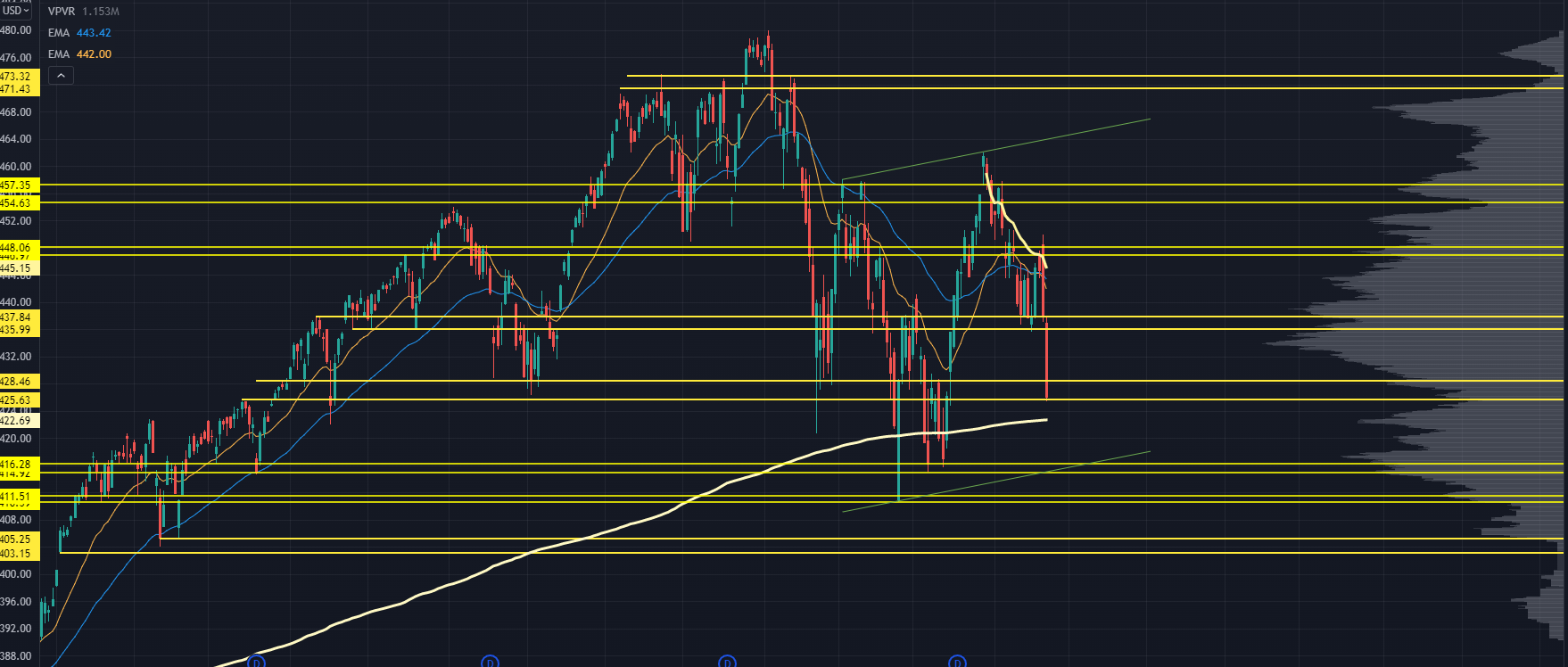
SPY Chart with key Price Levels
Friday saw a trainwreck of a market close. The past two days' action have felt like a persistent algorithmic seller on the tape. Clearly, someone wants out.
Prior to Thursday, we saw some signs of stabilization in the 435-437 zone. That's where buyers kept stepping up. They managed to do so on Thursday for a brief period, but selling accelerated through Friday.
The level the S&P finished at on Friday is still VERY valid. It’s possible that options flow exacerbated much of Friday’s selling. If that was it, you could easily see a bounce from here.
That doesn't feel like the most likely scenario, though. Plenty of short-term traders were betting on a bounce, and it simply didn't come... they'll be using any pops in the 4300s to unload inventory.
Above current prices, we have that 435-437 level. This level would require a ton of energy to reach, given how the back-to-back trend days we saw in the market. Above that is the market’s previous choppy range. Resistance runs from 444.50 all the way up to 448.
The Anchored Volume Weighted Average Price (AVWAP) from the March highs could come into play. Treat that as a dynamic level, as it will most likely line up with both the 20 and 50 EMAs.
Below, we have a sneaky level that could come into play right around 421. It's not marked, but it's the swing AVWAP from October 2020, along with a key low volume node.
Under there, and we come into "retest" territory. There's a minor level at 419, but I think the action would be at 414-416. It's hard to see, but there is a channel I've drawn in green. That "extrapolation" lines up with that 414-416 area, which would be a great buy — especially if we saw it with a gap down or a Tuesday morning capitulation.
It gets tricky underneath that because if we come into these levels this week, volatility will be cranked up and liquidity will be low. We've got the 410-411 zone, where we had the "war bottom" and prior pivots back from the summer of last year.
If the market has a huge move, we've got 403-405. If we hit it within the next two weeks, I’d be very aggressive against that level.
Right now, it feels like the market is going to fall apart, and that we’ll get a proper cascade lower. I’m biased against this since I see what’s priced in with some of the other markets. This isn't a "bullish" call, but more of a "range-bound" call.
Here are the Cliff's Notes: The Fed said inflation was transitory until November 2021, when they changed their tune.
Since then, they’ve signaled very hawkish policy changes coming over the summer.
When we see a transition in Fed policy, market volatility tends to increase. The years 2018 and 2012 offer other examples of this kind of uncertainty in play.
There can always be a "lag" in equities as they respond to other markets around the world, but let's take a quick look at ZQX2022:
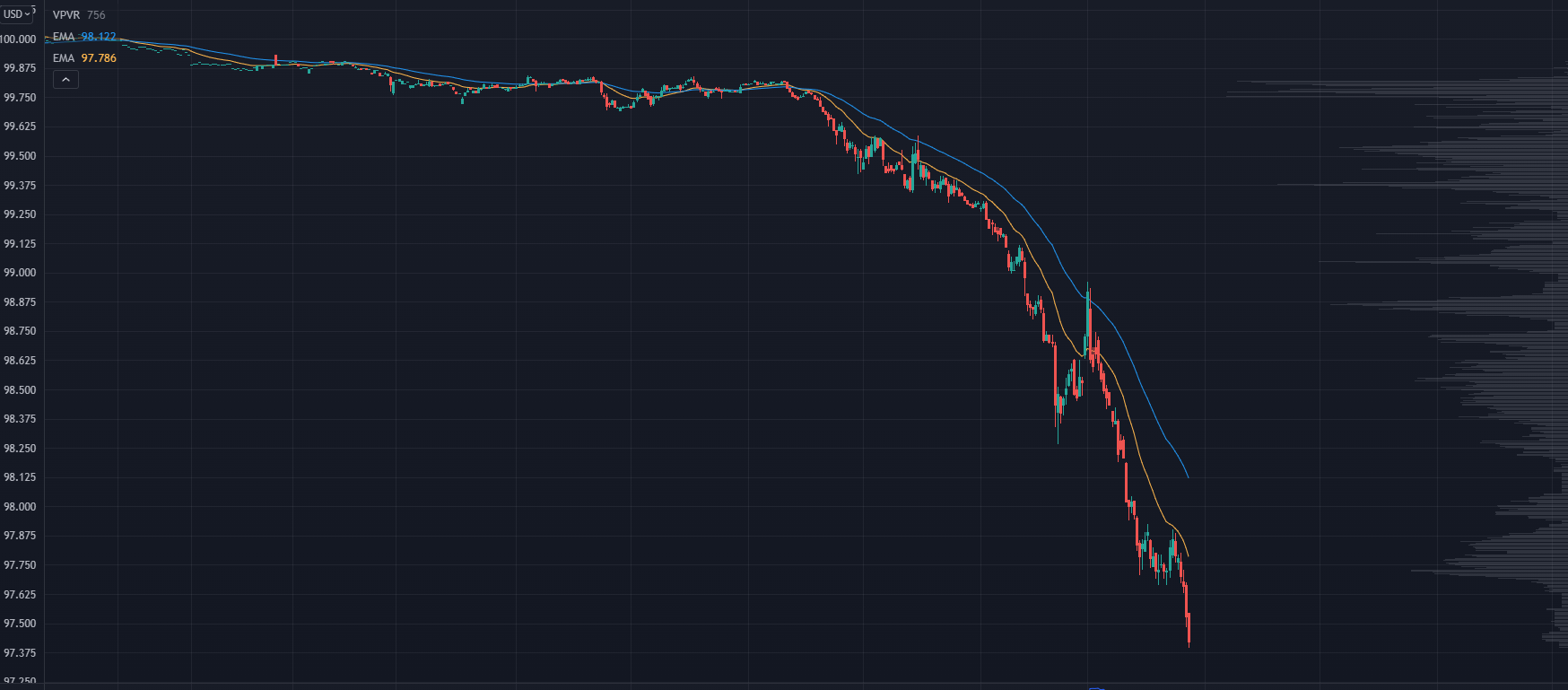
ZQX2022 Chart
This is a Fed Fund Futures contract, which allows market speculators to bet on what monetary policy could look like in the future…
And it's currently in a free fall.
Over the past few months, we’ve seen a massive repricing (in the markets) in what the expected interest rate will be.
This contract is for November. A month ago, the market was pricing in 200 basis points. Now it's pricing in nearly 300.
That's a 3% rate hike.
Now remember:
This is what we are seeing discounted in the future. Not the current rate.
For that, we can look at the true Fed Funds rate:
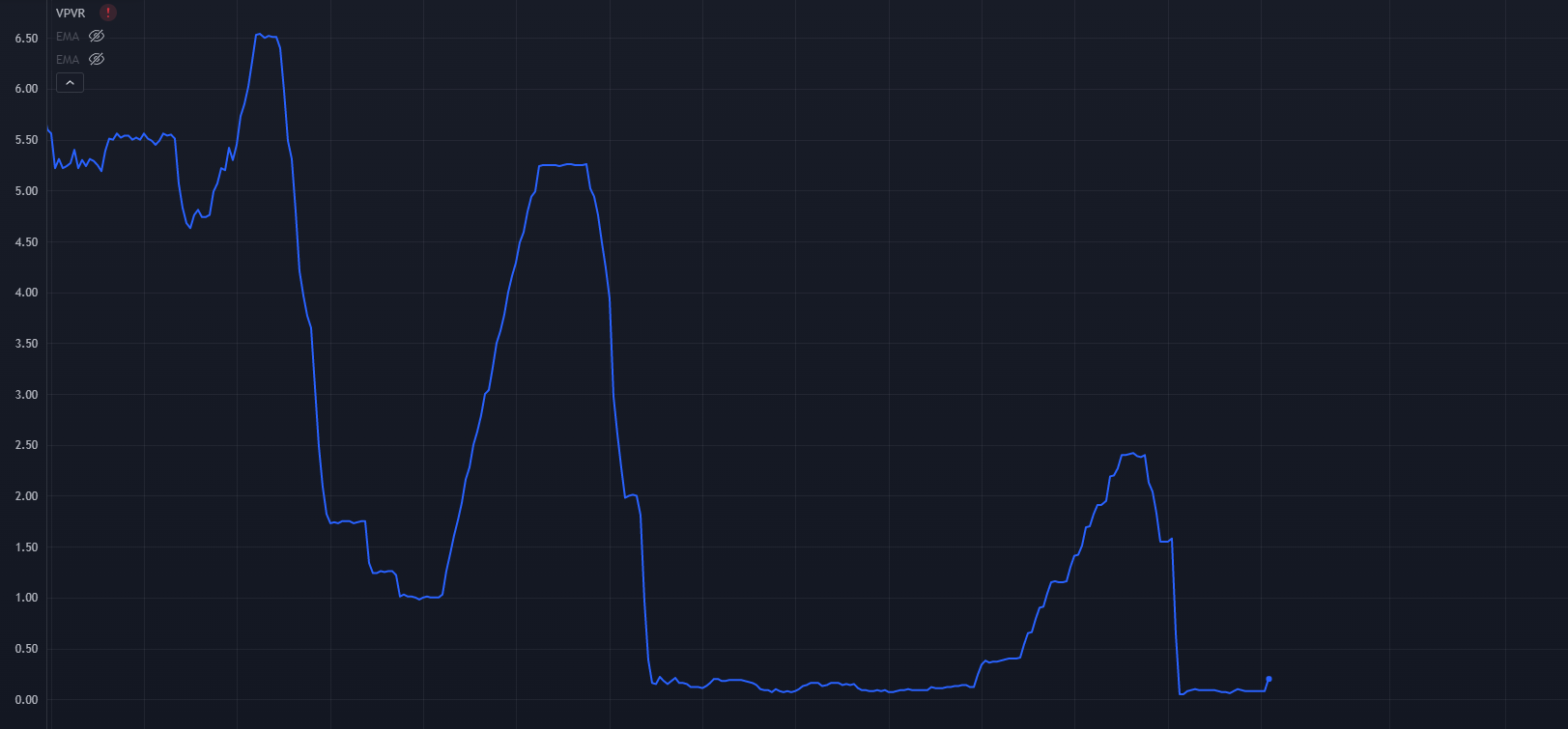
Fed Funds Rate
The last time we had a rate hike regime was 2018 — and we peaked around 2.5% before they relaxed it a bit because the market was getting absolutely crushed.
Look at where we are now... they haven't even started to hike!
All of the volatility we've seen in both bond and stock markets has been driven by signaling factors.
We've seen this before. It's called a "buy the rumor, sell the news" kind of event.
Here's my guess as to what's really going on behind the scenes:
The Fed still believes a good chunk of inflation is transitory. And to be fair, they could have a point.
Consider this: what percentage of the rise in gas prices has to do with monetary policy?
Sure, you've got increased demand from the fiscal stimulus that many countries employed in 2020. And maybe you can make the case for low interest rates providing an upside lift in oil.
But we've got a war in Europe right now. That's a "supply" issue, not a demand one.
The other thing to remember is that the Fed is absolutely a political organization, even if they claim neutrality.
They know inflation is the number one issue voters are concerned about, and those will crush the current regime when the polls open in November.
So what does the Fed do?
Talk.
Make some of the dovish members go out and say we need to hike rates.
They're trying to crush the inflation trade so that they can claim a victory in the fall.
Heck — I wouldn't be surprised if they were coordinating low-key with the State Department about when and how they might ink a peace deal in Ukraine.
It's about optics. It's about signaling. And if they can talk the inflation trade down, and then get peace in Eastern Europe…
They’ll look like heroes as we head into the midterms.
That's just on the US side.
China has the 20th National Congress of the CCP... and even though it's a uniparty, some internal conflicts are most likely playing out due to the lockdowns in Shanghai and potentially Beijing.
Boy, SPY went on longer than I thought it would... so I'll wrap this up with something to think about:
What happens to the markets if inflationary signals slow down?
Because right now, a LOT of risk is already priced into the bond markets. It can always get worse, but a lot of traders are leaning in one direction on this at the moment.
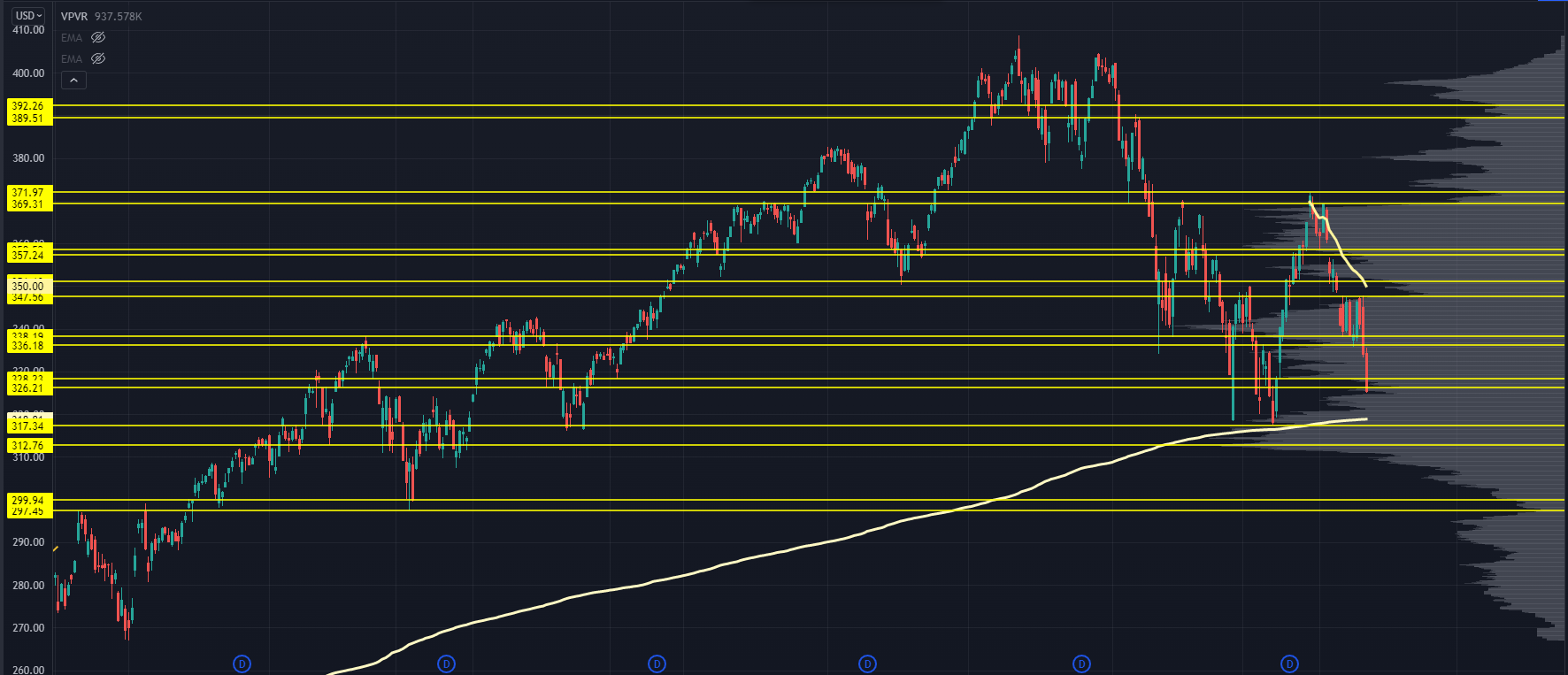
QQQ Chart with key Price Levels
We've made some adjustments on our Roadmap because the volume patterns shifted.
Like the SPY, This level has some potential for price response. If we haven't seen a nasty gap down on Monday, then you could see an early bounce...
I wouldn't bet too much on that holding on the first test, especially if we come into the 336 level.
The higher levels are all very similar to SPY. Pay careful attention to that swing Anchored VWAP against the March highs.
To the downside, we have the swing AVWAP from the 2020 lows that’s in play for a bounce.
Below that... it gets tricky. The next major level on our Roadmap is down at 297-299, but I know we have a minor level at 307 to work with — and we’ve seen some clean price responses into it.
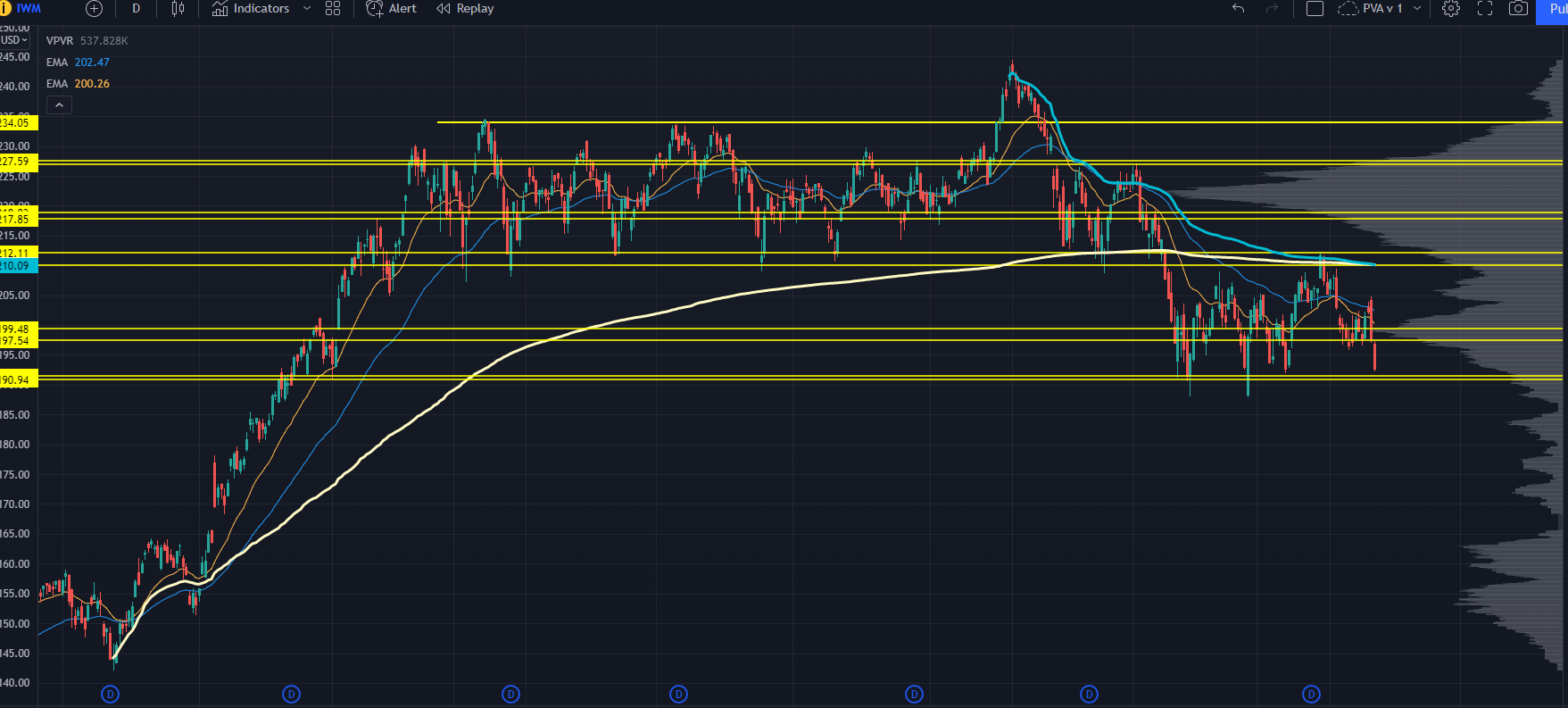
IWM Chart with Price Levels
The Russell 2000 is looking pretty trashy... and to be honest, I don't know how to map out levels underneath our current trading range because we just didn't have a lot of trade during it.
It shot straight up post-2020 election, so we don't have many market participants anchored off those levels.
We do have a huge level into 170, but that is a longer-term target.
Unless we absolutely crash I wouldn't expect to tag it anytime soon.
There is one scenario to consider, and that's the failed breakdown setup. My favorite example of this is from 2011:

Chart 2011 Breakdown
To put this in context, we were 2 years removed from the Great Financial Crisis... not sure we even called it that yet.
We also had the Eurozone crisis in 2010, and the Fiscal Cliff crash, where they got a deal done to fund the government…
But the S&P still downgraded US debt, leading to a huge drop.
The market then traded in a terrible choppy trading range before finally rolling over and breaking the lows.
We saw a gap down the next day and it looked like death.... and that was the bottom for the market.
Do not discount that possibility!
This market loves to buck off as many participants as it can before it can get going. And if we were to break the lows, a ton of traders would get beared up, shorting into the hole.
I'll be actively monitoring regional banks (KRE), biotech (XBI), and retail (XRT) since we don't have many levels underneath to work with.
That’s all for now.
Head here to learn more about our Trading Roadmap.
Original Post Can be Found Here